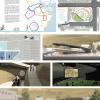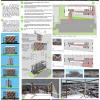2012 Intern /YA Design Competition
The AIANH Intern/Young Architect Design Competition was created to provide an opportunity for interns and young architectural professionals to strengthen their design skills, gain recognition, and assist a community with their design challenges. It is open to all architectural interns and architects within five years of registration living or working in New England. Participants do not need to be members of AIA.
2012 Competition
The 2012 competition was for an Urban Bicycle Station. Imagine walking to a sidewalk corner and finding a public bicycle. With a cellphone call or swipe of a card, you unlock it from its bike rack and ride it across town. Once at your destination, you steer to the closest bike rack and, with one more call or card swipe, return the bike to the public network. You pay a small charge for the trip, and the bike is once again available for the taking.
This vision is not far off for the city of Portsmouth and Bike-sharing programs as described above have become fixtures of progressive cities like Paris, Barcelona, and Montreal. With Montreal and Paris each having over 10,000 bikes at over 500 stations. Bike-sharing is revolutionizing transportation networks and greening the urban fabric.
Past Design Award Winners:
2012 Competition Results
2012 Jurors:
Christopher Carley AIA, Principal at C.N. Carley Associates, Concord, NH
Rob Harbeson AIA, Project Architect at DeStefano Architects, Portsmouth, NH
Liaquat Kahn, AET Department Head at the NH Technical Institute, Concord, NH.
The jury was impressed by the overall effort and passionate work put in by each of the 10 design submissions and noted the progression and increased thoroughness of the design entries since the first young architects competition many years ago.
Click on the thumbnail for each project to enlarge.
First Place:
Adam Lemire, LineSync Architecture, Wilmington, VT.
Jury Comments: Adam's design, The Loop, creates a subtle, formally graceful and powerful urban solution containing the most interesting public space out of all the entries. The flow and experience of the design is enjoyable and is reminiscent of someone riding on a bicycle. The handling of program creates a poetic experience from clear and simple goals that speaks to the movement of bicycles and the integration of bicycle routes along the seacoast of New Hampshire. The thoughtful consideration of site and context and integration of cycling, pedestrian, and public activity is successful by not trying to fill the proposed site with an overbearing building.
Second Place (tie):
Andrew M. Queen, Proc Con Inc., Hooksett, NH
Jury Comments: Andrew Queen's submission, The Cycle Tower, presents a bold concept creating a new icon for the city of Portsmouth. It contains strong organizing principles and its use of sustainable materials deserves merit for a valiant attempt towards a unique building typology. It was noted that the monumental buildings scale seemed to be a bit overpowering and lacked language that was consistent with the formal context and historical surroundings of the city of Portsmouth, but it successfully created a integrated flow and movement throughout the plan that simply solves many issues of the programmatic spaces for this competition.
Second Place (tie):
Nathan Stolarz AIA, Prellwitz/Chilinski Associates, Cambridge, MA.
Jury Comments: Nathan Stolarz's concept, The Life Cycle, takes an urban point of view approach creating a tectonic expression and architectural image of spinning spokes along the Daniel Street Facade evoking an interesting celebration of bicycle culture. Though this building seems to be more about the street and has some overpowering scale issues, it creates a design that is transparent for the community carrying a light, airy, and simple framed building juxtaposed to the heavier darker brick buildings along Daniel Street. The submission boards' ability to communicate ideas visually with quality, completion and clarity is highly effective and shows a production skill of a high quality standard of work.


